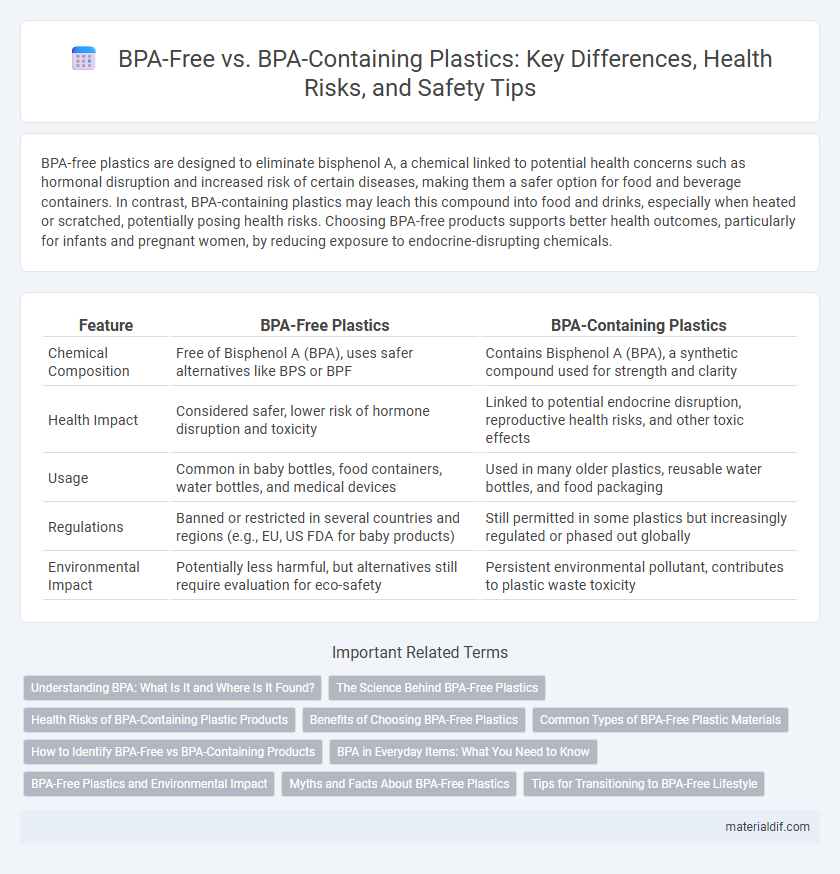BPA-free plastics are designed to eliminate bisphenol A, a chemical linked to potential health concerns such as hormonal disruption and increased risk of certain diseases, making them a safer option for food and beverage containers. In contrast, BPA-containing plastics may leach this compound into food and drinks, especially when heated or scratched, potentially posing health risks. Choosing BPA-free products supports better health outcomes, particularly for infants and pregnant women, by reducing exposure to endocrine-disrupting chemicals.
Table of Comparison
| Feature | BPA-Free Plastics | BPA-Containing Plastics |
|---|---|---|
| Chemical Composition | Free of Bisphenol A (BPA), uses safer alternatives like BPS or BPF | Contains Bisphenol A (BPA), a synthetic compound used for strength and clarity |
| Health Impact | Considered safer, lower risk of hormone disruption and toxicity | Linked to potential endocrine disruption, reproductive health risks, and other toxic effects |
| Usage | Common in baby bottles, food containers, water bottles, and medical devices | Used in many older plastics, reusable water bottles, and food packaging |
| Regulations | Banned or restricted in several countries and regions (e.g., EU, US FDA for baby products) | Still permitted in some plastics but increasingly regulated or phased out globally |
| Environmental Impact | Potentially less harmful, but alternatives still require evaluation for eco-safety | Persistent environmental pollutant, contributes to plastic waste toxicity |
Understanding BPA: What Is It and Where Is It Found?
Bisphenol A (BPA) is an industrial chemical used primarily in the production of polycarbonate plastics and epoxy resins found in various consumer products such as water bottles, food containers, and the linings of metal cans. BPA-containing plastics have raised health concerns due to their potential to leach into food and beverages, possibly disrupting endocrine function. BPA-free plastics are manufactured using alternative compounds designed to eliminate these risks, offering safer options for food and drink storage.
The Science Behind BPA-Free Plastics
BPA-free plastics utilize alternative compounds such as bisphenol S (BPS) or bisphenol F (BPF), designed to avoid endocrine-disrupting effects linked to bisphenol A (BPA). Scientific studies reveal that BPA interacts with estrogen receptors, potentially causing hormonal imbalances and health risks, while BPA-free alternatives show reduced binding affinity. Regulatory agencies emphasize ongoing research to evaluate the long-term safety profiles of BPA substitutes in consumer products.
Health Risks of BPA-Containing Plastic Products
BPA-containing plastic products release bisphenol A, an endocrine disruptor linked to hormonal imbalances, reproductive issues, and increased risk of certain cancers. Exposure to BPA is particularly harmful to infants and pregnant women, as it can interfere with fetal development and brain function. Choosing BPA-free plastics significantly reduces these health risks by eliminating direct contact with this toxic chemical.
Benefits of Choosing BPA-Free Plastics
BPA-free plastics eliminate exposure to bisphenol A, a chemical linked to hormonal disruptions and health risks such as reproductive issues and increased cancer risk. Choosing BPA-free options ensures safer food and beverage storage by preventing chemical leaching into consumables, especially when heated. This safety improvement supports better overall health and is increasingly important in products like water bottles, baby containers, and food packaging.
Common Types of BPA-Free Plastic Materials
BPA-free plastics commonly include polyethylene terephthalate (PET), high-density polyethylene (HDPE), polypropylene (PP), and polystyrene (PS), which are widely used in food and beverage containers for their safety and durability. These materials do not contain bisphenol A, a chemical linked to health risks in BPA-containing plastics like polycarbonate. Choosing BPA-free plastics helps reduce exposure to endocrine disruptors while maintaining functionality in everyday products.
How to Identify BPA-Free vs BPA-Containing Products
To identify BPA-free products, check for labels explicitly stating "BPA-free" or look for recycling codes 1, 2, 4, 5, or 6, as plastics with code 7 may contain BPA. BPA-containing products often include polycarbonate plastics marked with recycling code 7 or have a hard, clear plastic appearance. Consumer awareness of labels and resin identification codes helps in selecting safer, BPA-free plastic items for food and beverage storage.
BPA in Everyday Items: What You Need to Know
BPA, or bisphenol A, is a chemical commonly found in many plastic products such as water bottles, food containers, and receipts, raising health concerns due to its endocrine-disrupting properties. BPA-free plastics have surged in popularity as safer alternatives, reducing the risk of hormone-related issues linked to BPA exposure. Consumers should check product labels carefully and prefer BPA-free options, especially for items used to store food or beverages, to minimize potential health risks.
BPA-Free Plastics and Environmental Impact
BPA-free plastics eliminate bisphenol A, reducing potential hormone disruption and health risks linked to BPA-containing materials. These plastics often use alternatives like BPS or BPF, though their environmental profiles vary and require further study. Choosing BPA-free plastics can decrease human exposure to harmful chemicals, but assessing the overall environmental impact demands consideration of production, recyclability, and degradation factors.
Myths and Facts About BPA-Free Plastics
BPA-free plastics are often perceived as completely safe, but some may contain alternative chemicals like BPS or BPF, which have not been extensively studied for health effects, challenging the myth that BPA-free means risk-free. Scientific research indicates that BPA-containing plastics can leach endocrine-disrupting chemicals, particularly when heated, debunking the belief that all plastics are equally inert. Understanding the chemical composition and exposure risks of both BPA-free and BPA-containing plastics is essential for making informed health-conscious choices.
Tips for Transitioning to BPA-Free Lifestyle
Switching to a BPA-free lifestyle involves replacing plastic containers, water bottles, and food storage items marked with BPA or recycling codes 3 and 7 with BPA-free alternatives made from glass, stainless steel, or polypropylene. Prioritize products explicitly labeled as BPA-free to reduce endocrine-disrupting chemical exposure linked to health issues such as hormonal imbalances and reproductive problems. Gradually update your kitchen and personal care items, and avoid heating food in plastic containers to minimize BPA leaching and ensure a safer, toxin-free environment.
BPA-Free vs BPA-Containing Infographic

 materialdif.com
materialdif.com